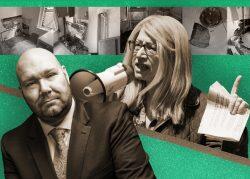Housing advocate Cea Weaver has sent sparks flying across landlord-tenant Twitter since late last week, when she posted that rent-stabilized owners crying poor are more likely crying wolf.
The tweet came in response to a video by the Community Housing Improvement Program, a landlord group, highlighting the estimated 20,000 rent-stabilized units allegedly rendered unrentable by the state legislature in 2019.
The clip shows a string of unfinished apartments that sit vacant because the law prevents property owners from raising the rent enough to pay for repairs. If Albany would let owners set a new rent when a tenant vacates, CHIP argues, landlords would fix and lease those units, easing the city’s housing crisis.
Weaver’s reply tore through that argument: “Maybe landlords should take some of the tremendous amount of equity and value they have accrued via New York City real estate values and invest [it] back in the building, and rent out the unit or something, idk.”
For landlords who’ve spent the last three years decrying the impact of the rent law, the quip added insult to injury.
It was also a political blow, signaling that Housing Justice for All’s Weaver — instrumental in passing the 2019 rent law — has no interest in changing it to get the empty units back on the market. (In fact, she wants the law expanded.)
The advocate’s tweet spurred instant backlash from owners.
The more hospitable ones laid out their financial straits. A landlord named Rob claimed the Rent Guidelines Board’s rent increases — less than 6 percent in six years — haven’t covered his increase in operating costs, let alone repairs.
“Small owners have seen their equity disappear,” he wrote.
Even for owners who have equity, Weaver’s idea won’t fly, one tweet said, because “‘Taking out equity’ is just borrowing money that has to be paid back and paid back with the revenue generated from the rents.”
Others were less polite.
Read more



“Let me dumb it down for you Cea,” tweeted a user named Gerardo. “It costs Mcdonalds [sic] $1 to make a hamburger. They are not allowed to charge more than .80 cents. Why would they want to be in the business of selling hamburgers? Understand?”
Another urged Weaver to “take an economics class.”
But Weaver, no stranger to Twitter beef, doubled down. In an interview with The Real Deal, the Housing Justice for All organizer pointed to data showing stabilized landlords raking in monthly profits as their property values have soared.
The Rent Guidelines Board pegs owners’ net operating income at $585 per month or nearly 40 percent of rent. And that could be an underestimate, an analysis by the nonprofit University Neighborhood Housing Program suggests. A look at the city’s Freddie Mac Small Balance Loan recipients, 70 percent of which are rent-stabilized owners, shows property owners pocketing 62 percent to 75 percent of rental revenue.
Weaver added that “irrespective of cash flow,” rent-stabilized property values have “increased tremendously” over the past several decades, meaning landlords should hold the equity to finance repairs. A separate analysis by the University Neighborhood Housing Program shows the average sale price of stabilized properties in the Bronx rose to $175,000 per unit in 2020 from $10,500 in 1996, an annual growth rate of 12.4 percent.
Landlords have challenged each of those data points.
CHIP released figures this summer showing the average rent-stabilized landlord operates at a loss of $126 per month. Unlike the rent board, CHIP factored in mortgage payments and capital expenditures. The group’s data also accounts for current inflation; the board’s analysis is two years old.
And since the rent law passed, buildings it governs have lost value. Even before Covid hit, the NYU Furman Center found that while the value of all rental properties dipped by $90 per square foot, stabilized buildings were down by $140.
But owners’ arguments haven’t swayed lawmakers or tenant advocates. If Weaver’s tweet evoked an outcry from owners, CHIP’s video triggered a similar deluge from users questioning landlords’ claims.
“Has no landlord ever heard of cross-subsidy?” the video’s first reply reads. “Rental income is fungible, and the income from an entire portfolio could easily pay for the renovations to these units.”
Building owners say providing subsidies is the government’s responsibility, not theirs.
Legislators such as Assembly member Linda Rosenthal, meanwhile, are convinced that owners are holding stabilized units hostage to pressure Albany to amend the rent law. CHIP reinforced that belief when it offered to fix and re-rent the vacant units if the state would let them set a new initial rent. That’s exactly the policy that tenant advocates struggled for years to overturn before succeeding in 2019.
Rosenthal said even when the legislation first passed, owners said they would pull listings.
“No one discussed, ‘Oh, they need too much repair,’” she said. “They were just willfully taking them off the market.”
Still, CHIP’s executive director, Jay Martin, claimed the group’s campaign, in its four-month run, has made “a bit” of progress. Several members of the state Senate and Assembly have acknowledged the catch-22 that the rent law created for landlords, he said, enabling CHIP to build “a good coalition” to change it.
Despite the housing crunch and rising rents, any change seen as benefiting landlords is an uphill battle in Albany. Martin said he would not say which lawmakers supported the group’s campaign “until language is ironed out.”
Tenants’ lawyers, meanwhile, have demanded stronger protection for renters, calling on state lawmakers to pass good cause eviction in a special session.
Given the environment, Weaver characterized CHIP’s campaign as “wildly tone deaf.”
“There are people who have access to wealth and resources … who can take steps to alleviate this crisis,” she said.
